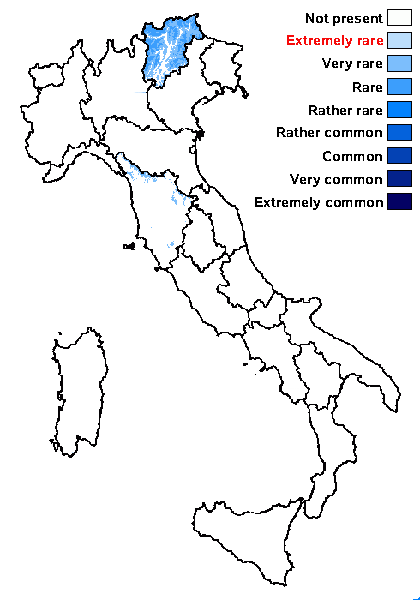Rinodina epimilvina H. Mayrhofer
J. Hattori Bot. Lab., 55: 408, 1984.
Synonyms:
Distribution: N - TAA (Giralt & Llimona 1997). C - Tosc.
Description: Thallus crustose, episubstratic, whitish to cream-coloured, 0.3-0.4 mm thick, rimose-areolate to verrucose, the areoles contiguous, flat to convex, up to 1 mm wide, starting the life-cycle on the thalli of Rinodina milvina, later sometimes becoming autonomous. Apothecia lecanorine to cryptolecanorine, up to 0.8 mm across, immersed in the thallus to adnate or subsessile, usually crowded and sometimes confluent, with a dark brown to black, persistently flat disc, and an initially thick and prominent, finally sometimes excluded thalline margin. Epithecium dark brown; hymenium colourless, up to 80 μm high; paraphyses c. 1.5 μm thick at mid-level, the apical cells capitate, 3-5 μm wide, with a dark brown cap; hypothecium colourless to pale yellow, up to 200 μm high. Asci 8-spored, clavate, the K/I+ blue tholus penetrated by a faintly amyloid apical cushion with parallel or diverging flanks, the wall K/I-, surrounded by a K/I+ blue outer layer, Lecanora-type. Ascospores 1-septate, brown, ellipsoid, (15-)16-18(-20) x (7.5-)8-10(-11)μm, Milvina-type, with an ornamentation of coarse warts, the torus well-developed, the ontogeny of type A (apical wall thickening after septum formation). Photobiont chlorococcoid. Spot tests: thallus K+ yellow, C-, KC-, P+ faintly yellow. Chemistry: atranorin, zeorin.
Note: on acidic siliceous rocks wetted by rain in upland areas, starting the life-cycle on Rinodina milvina; not common, but certainly more widespread than the few records would suggest, especially in the Alps, with optimum above treeline.
Growth form: Crustose
Substrata: rocks
Photobiont: green algae other than Trentepohlia
Reproductive strategy: mainly sexual
paras Rinodina milvina
Commonnes-rarity: (info)
Alpine belt: rare
Subalpine belt: very rare
Oromediterranean belt: absent
Montane belt: very rare
Submediterranean belt: absent
Padanian area: absent
Humid submediterranean belt: absent
Humid mediterranean belt: absent
Dry mediterranean belt: absent

Predictive model
Growth form: Crustose
Substrata: rocks
Photobiont: green algae other than Trentepohlia
Reproductive strategy: mainly sexual
paras Rinodina milvina
Commonnes-rarity: (info)
Alpine belt: rare
Subalpine belt: very rare
Oromediterranean belt: absent
Montane belt: very rare
Submediterranean belt: absent
Padanian area: absent
Humid submediterranean belt: absent
Humid mediterranean belt: absent
Dry mediterranean belt: absent

Predictive model
 Index Fungorum
Index Fungorum
 GBIF
GBIF

